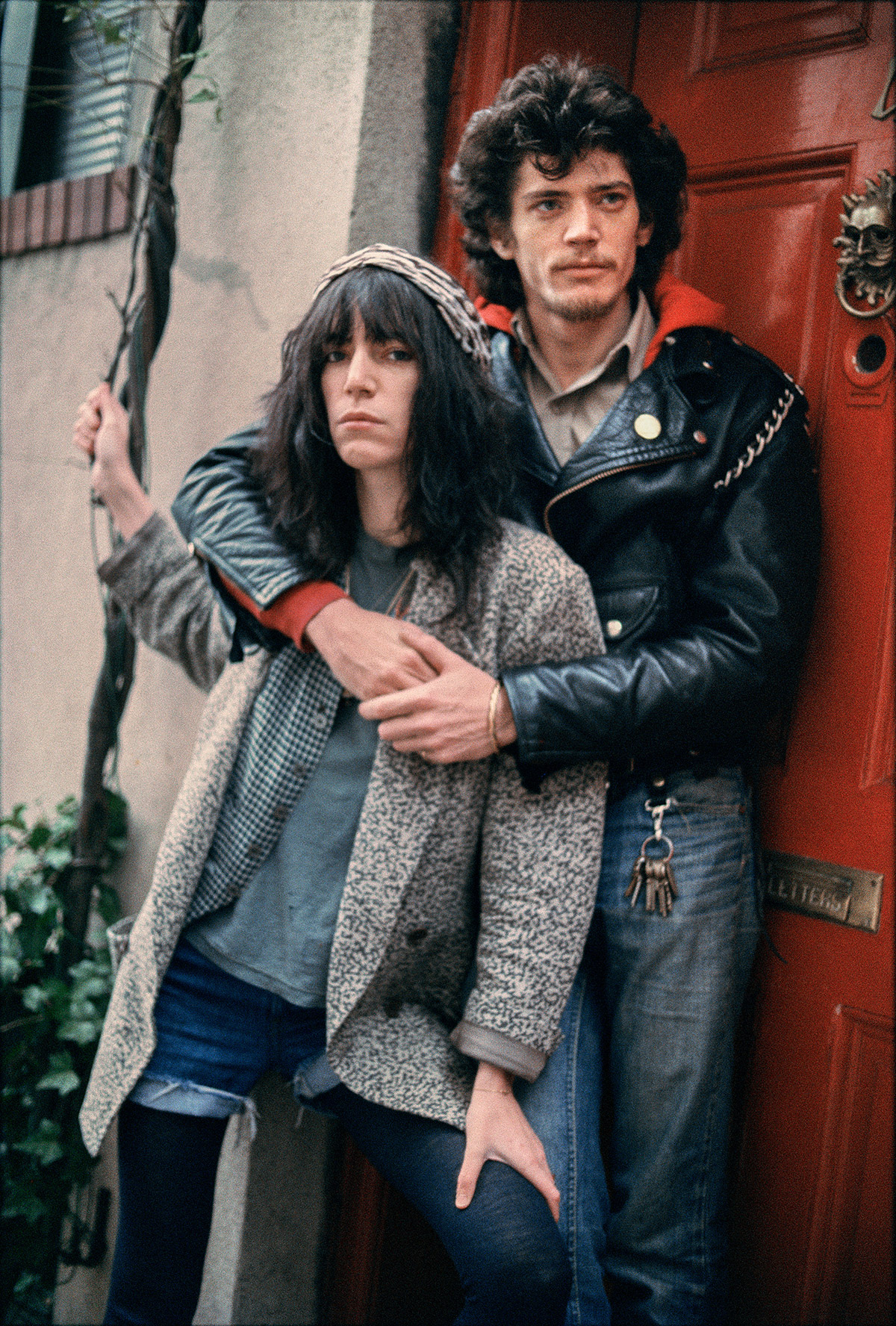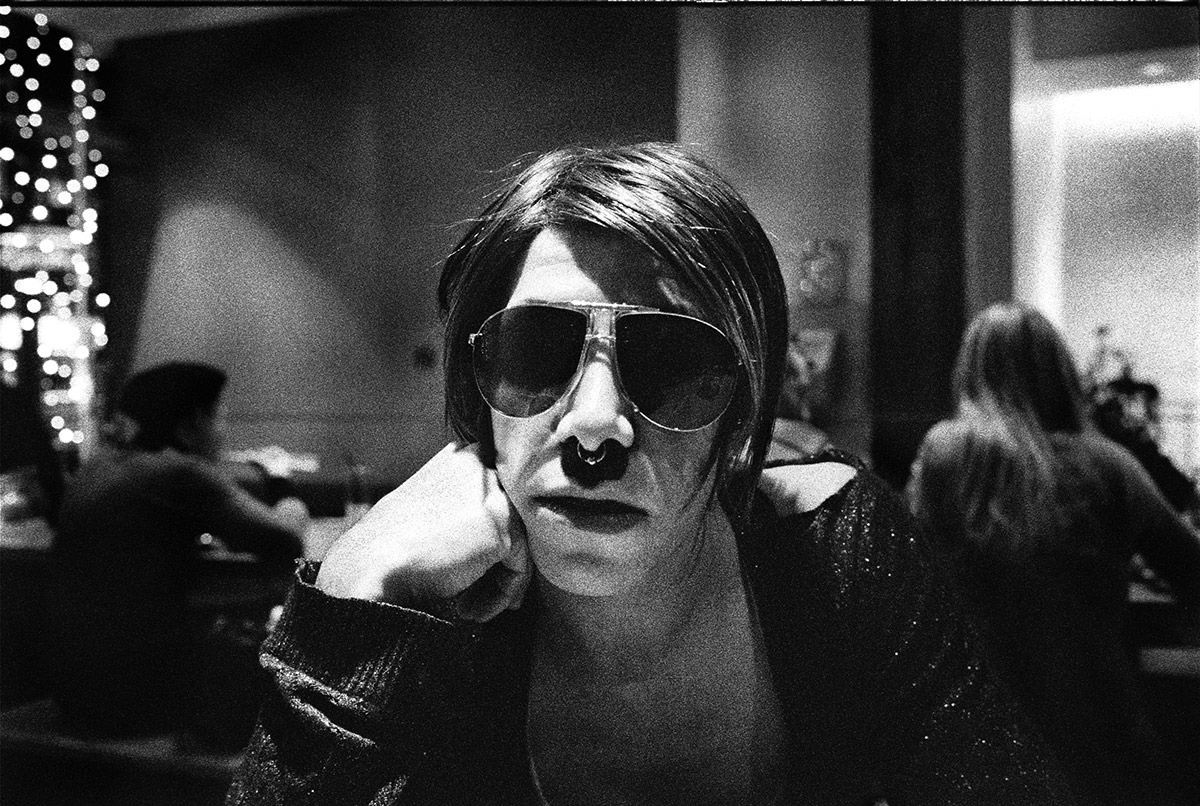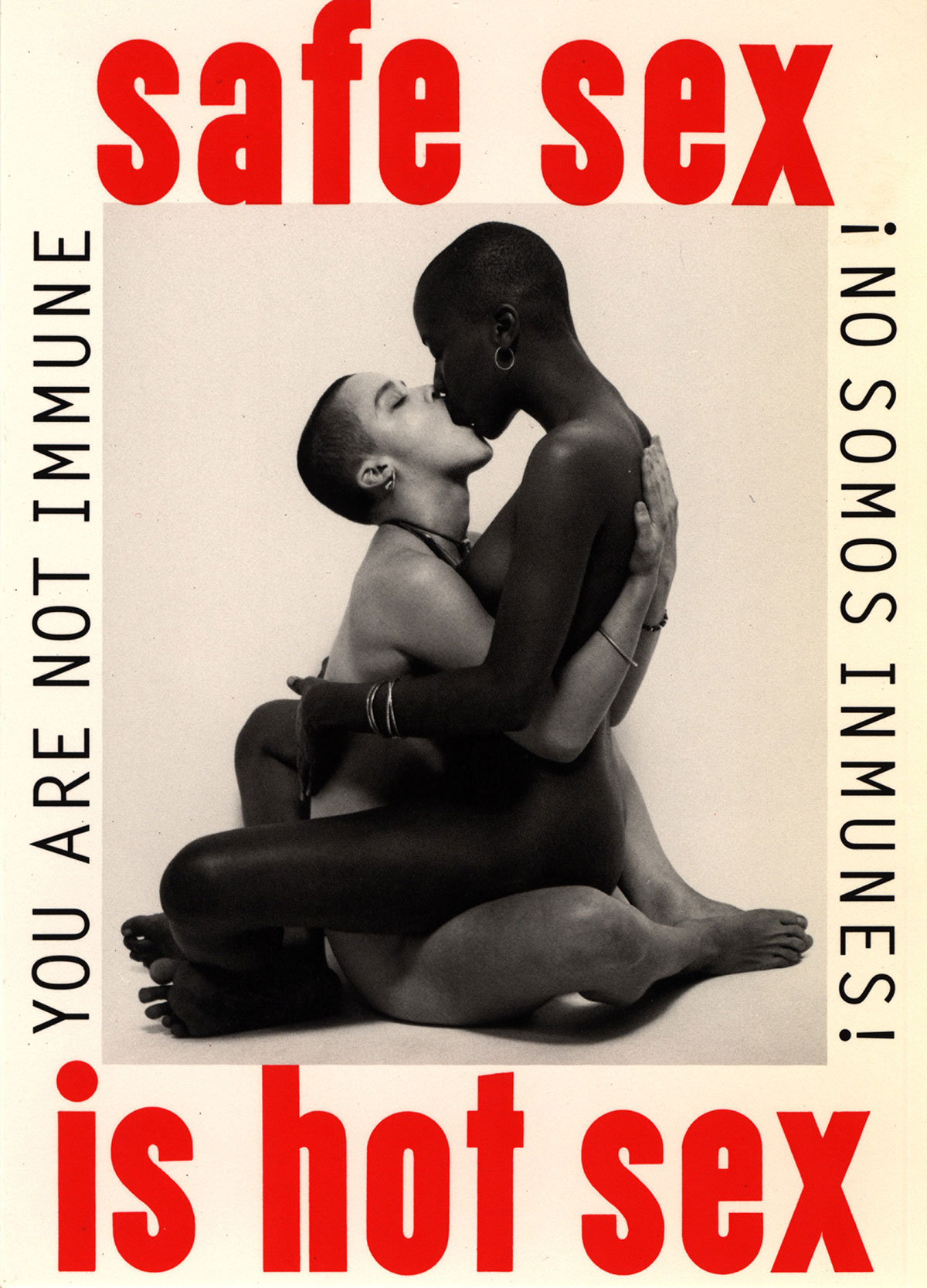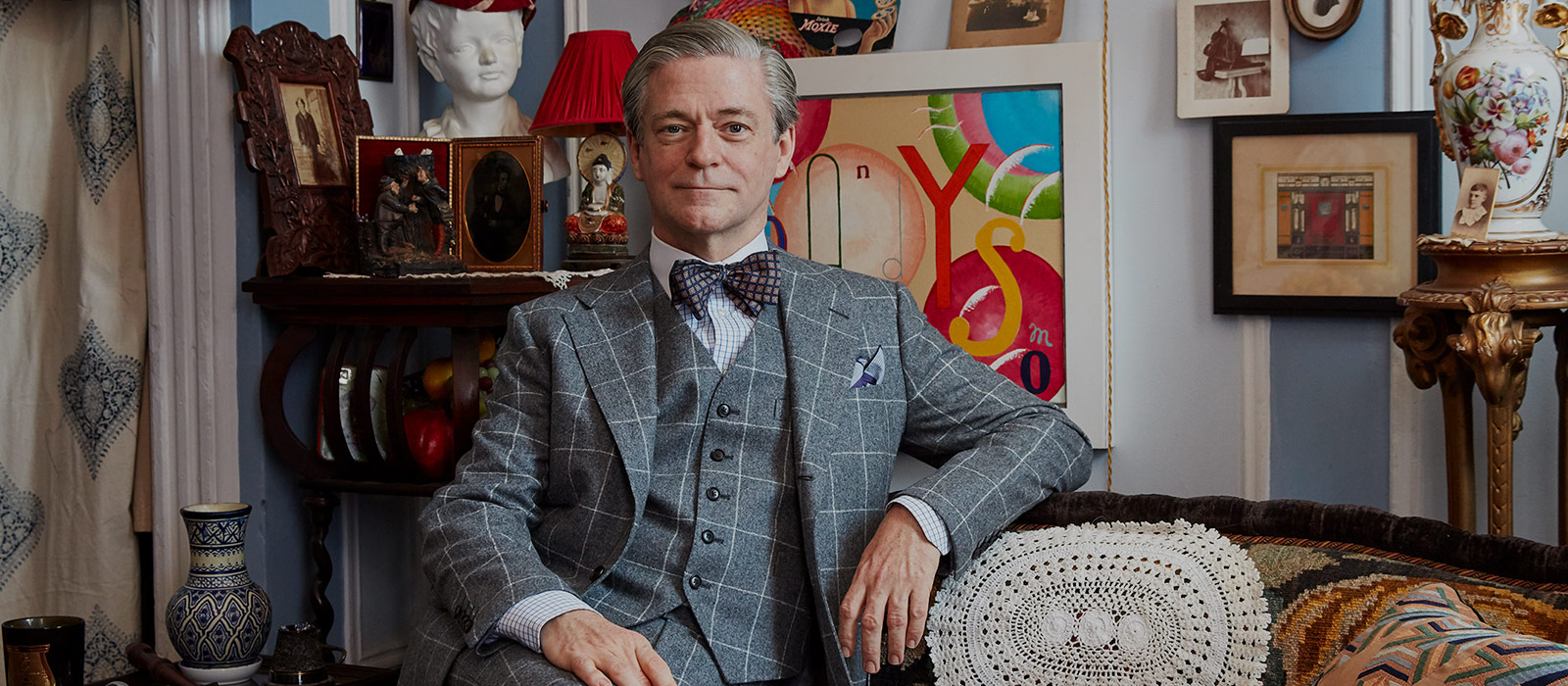
Peter McGoughBeyond Time
A conversation with Peter McGough by Kate Simon.
In the ever-changing cultural landscape of New York City, Peter McGough stands as one of the most unique and engaging artistic voices of the past 40 years. McGough first rose to prominence during the burgeoning downtown arts scene of the early 1980’s. It was a time when artistic expression became infused by the social and cultural revolutions that had swept through the country over a decade before, changing art, culture and the city forever.
From the now legendary “Friends of Dorothy” through to the groundbreaking and deeply personal “Oscar Wilde Temple”, McGough’s cross-disciplinary work embraces time and identity in both the permanent and the ephemeral.
As part of our celebration for Pride month, we bring together two brilliant artistic minds, Kate Simon and Peter McGough in this candid and no-holds-barred conversation.
Louie Chaban.
You May Also Like: Pride Month 2021. Celebrating LGBTQIA+ Voices.
Kate Simon: Peter, it’s so nice to talk to you. I have a few things I’d like to talk you about; one is your Oscar Wild Temple but first let’s talk about your outstanding memoir, I Have Seen the Future And I’m Not Going. And, then, I would like to talk about your beautiful large yellow piece because that is such a great painting and this interview is in honor of Pride Month.
So, should we start?
Peter McGough: Yes, please.
Kate: So, I just want to say that I really adored your book, I Have Seen the Future And I’m Not Going, which is, for people who don’t know, about AIDS, the arts scene and downtown New York in 1980s. I recommend it to everyone, your audio version as well as the written version because you’re just outstanding. You’re wonderful in re-creating people that you know and I that know and I can hear their voices. You do a really good job.
Peter: Well, thanks. I thought when I did it, they told me that I was one of the few people that made hardly any mistakes. When I finished it, I thought “oh, they should have just hired some English actor to read it nicely. It is too comical.” But then I thought, “who cares? it’s probably funnier” you know?
Kate: I love the way you did Jacqueline (Schnabel.) You did Jacqueline beautifully and you made Jacqueline really sound like Jacqueline. I love when you did David McDermott. You did David perfectly.
Peter: After 40 years of his hijinks, I think I know how to do his voice.
Kate: In your book, you refer to your shyness as a child and always thought of yourself as an “idiot.” And, I just wanted to ask you… how did you metamorphose? How did you cultivate the courage it requires to not only be a well-regarded artist, but also to have the courage to face your AIDS diagnosis and take the advice that you were given and that you needed to focus on your recovery?
Peter: Well, I was a shy child when I learned I had to keep being gay a secret. I learned in 5th grade that it was not something to be spoken about and I was mocked for my femininity. The thing about being an artist – that piece of paper that the child draws on, that’s their life. That drawing for me was the place that I felt safe in, where I could dream in. That I could make my own world where there wouldn’t be a slap or insult. That’s I think, how I experienced being an artist. And my mother, as nutty as she is, encouraged it. She just gave me anything I wanted as art supplies.
Kate: Can I interject for a second? Glenn (O’Brien) always told me, because I did some interviews for him when I was working with him at Interview. He always said, “Kate, when you’re doing your interview, make sure you let the other person speak.”
(both laugh)
God bless you. You know, but I was gonna ask you that question actually because you talk about your mother and her rages, and simultaneously say that if not for your mother… that she was the reason you became an artist. Right?
Peter: I feel for my mother with her mother, my grandmother who was a very difficult, very domineering personality.
Kate: Wait a minute. So that means that Mamie, who is the grandmother…?
Peter: No, no, no, no. Gran. My father’s mother was a dream. Gran was a Scottish cook, she was a maid and a cook for the Mainline of Philadelphia. And, she was a servant with her husband and her sister. They were all servants. And, she was mean. Her husband was an alcoholic who beat my mother. And, so, I could understand my mother now. I can understand her rages. And, I feel for her, but she scared me. And, made me become afraid of the world, and I was gay too, so I had to be doubly suspicious. She pushed me to be an artist, and when I wanted to become an actor in High School because I was in a play, she said, “don’t forget about your art.”
You May Also Like: Fashion Designer Marc Jacobs in conversation.
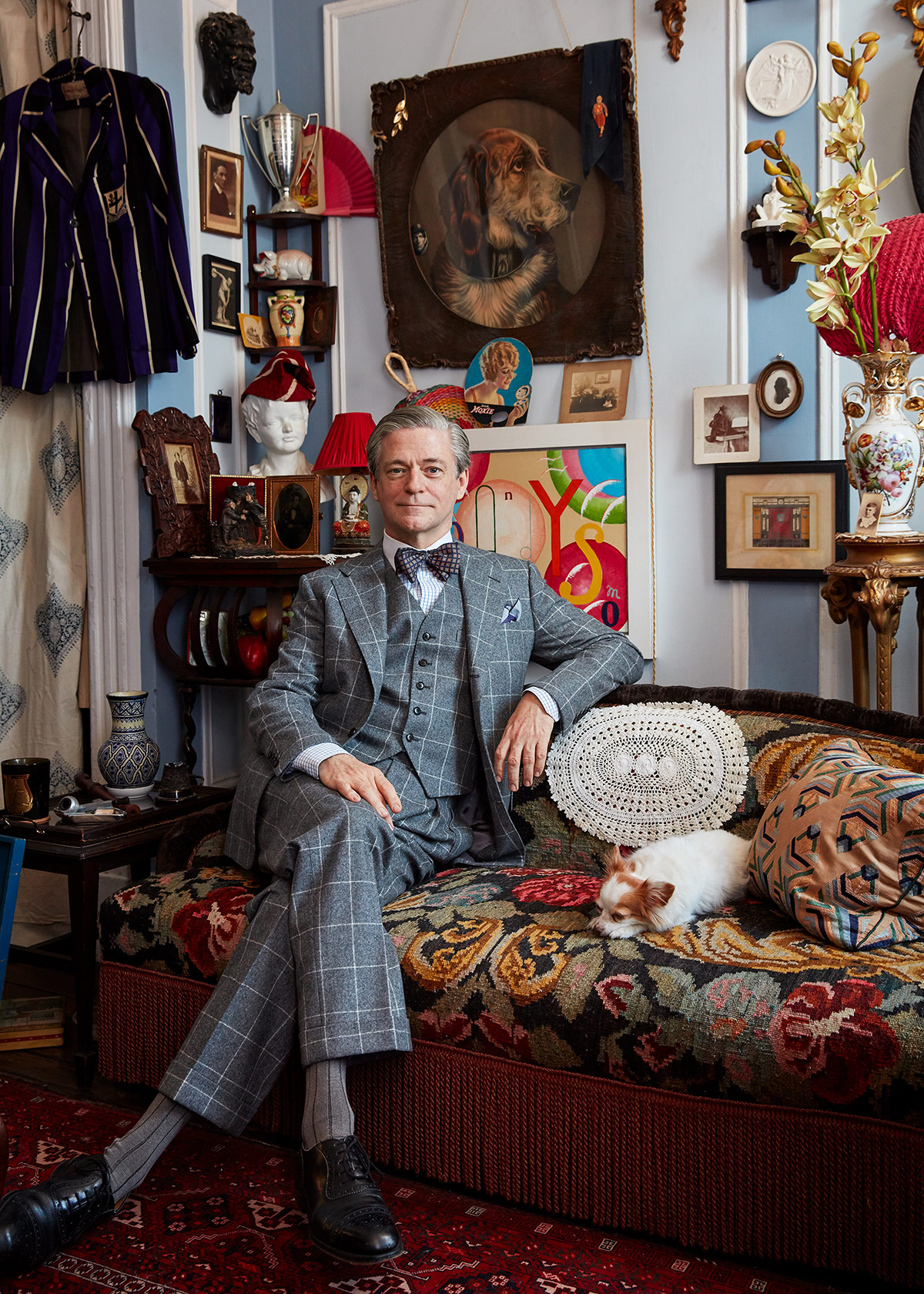
Kate: Interesting.
Peter: I don’t know if it helped me or hindered me, but she always pushed that. She’d drive me to exhibitions that I was in. She’d pin pictures of me in the newspaper, second prize in this art thing, art competition. She was very, very, very encouraging, always showing off my paintings, my drawings to whomever. So, it was weird, but yes. That’s how I became an artist. And, I tried everything else. Like I’ve made films, I made different things, but it always goes back to the art. That’s my true passion. Because I’m alone, I can be by myself. I can create a world on a canvas that is something that I feel is important. And I really brought in with my old partnership with McDermott, I brought in the LGBTQ issues. He was about the past. I brought in the homoeroticism and gay rights, LGBTQ rights. I made a painting in the 80’s that said, “I Changed My Sex,” that had a picture of a man in woman’s clothing. And I was looking at the painting and I thought did they really change their sex? Maybe this is their right sex. Out of complete naivety. The only trans person I knew was Marsha P. Johnson on Christopher Street — you know, friendly, not a friend. I didn’t go to lunch with her — and Dawn Langley Simmons in Hudson, New York. So, those were only two trans people that I knew. So, I then I put on the bottom of this little painting these little screw holes, and I wrote, “Or Did I?” So, it said “I Changed My Sex… Or Did I?”
So, then the “Friend of Dorothy” painting that says “Faggot, Fairy, Queer, Nelly, Pansy…” I had seen a Stuart Davis, an artist, a 20th-century artist, who was one of my favorite artists as a teen and in my early 20’s. He had a café in New Jersey called the “Gar Sparks Nut Shop” and, Gar Sparks stole Marcel Duchamp’s “Nude Descending a Staircase” from the Armory (show) of 1914.
He sold art. He was friends with Davis and asked Davis to paint him a mural on his Nut Shop in Elizabeth, New Jersey. It was like a soda fountain and he wrote, “Lemonade, Ice Cream, Soda” in all of these weird letters, and I thought, what a fabulous looking mural. I don’t wanna paint ice cream or lemonade, but that’s a good idea down the road.
(David) McDermott was like, “why don’t you do World War I battles?” And I was like, that’s so boring. And, I made a painting.
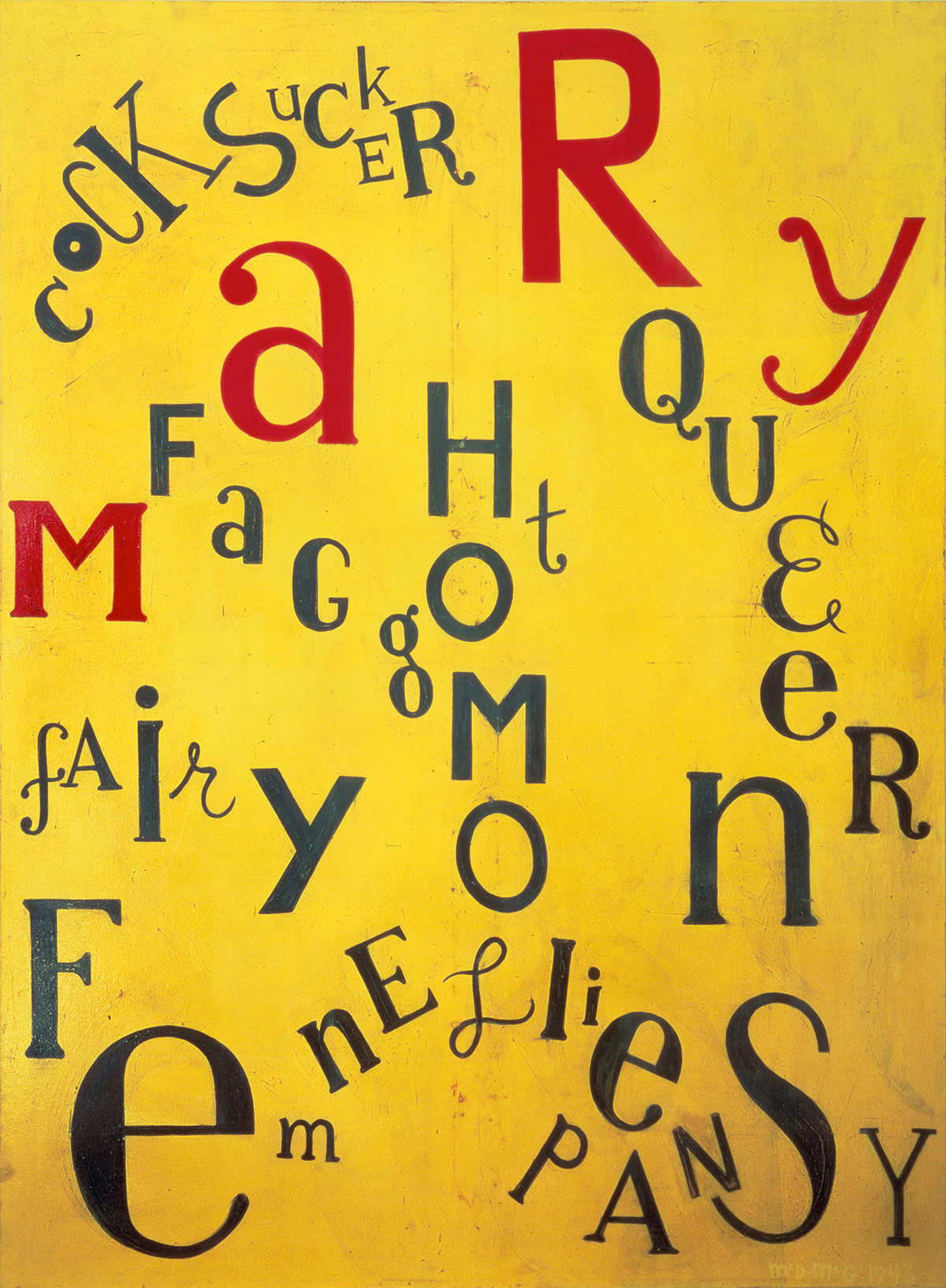
Kate: World War I battles?
Peter: Well, he loved history. I was in Julian Schnabel’s in Bridgehampton in the 80’s, and he gave me this huge canvas and said, “make a painting.” And, I was like, what? Cause it looked like a mural next to the size paintings we were making and that’s where I started it, and I just thought, “homo, fairy…” and I thought of the Stuart Davis and then Julian came over and goes “hey!” and I thought, oh no! He’s going to get upset and he goes, “you’re using all the colors I mixed!” And I said, I’m sorry, and he goes, “oh, go ahead. Who cares?” And then, everyone came around and they were all thrilled with it and then it went into… you know… it became one of the most famous paintings of that decade.
Kate: Now, what’s the name of that painting, Peter?
Peter: “A Friend of Dorothy’s,” which is a code in the second World War. They’d go to a gay party… and say to each other, “any friends of Dorothy here?” And it became such a saying that US military was like, “we need to find who this Dorothy is. It’s a spy ring.”
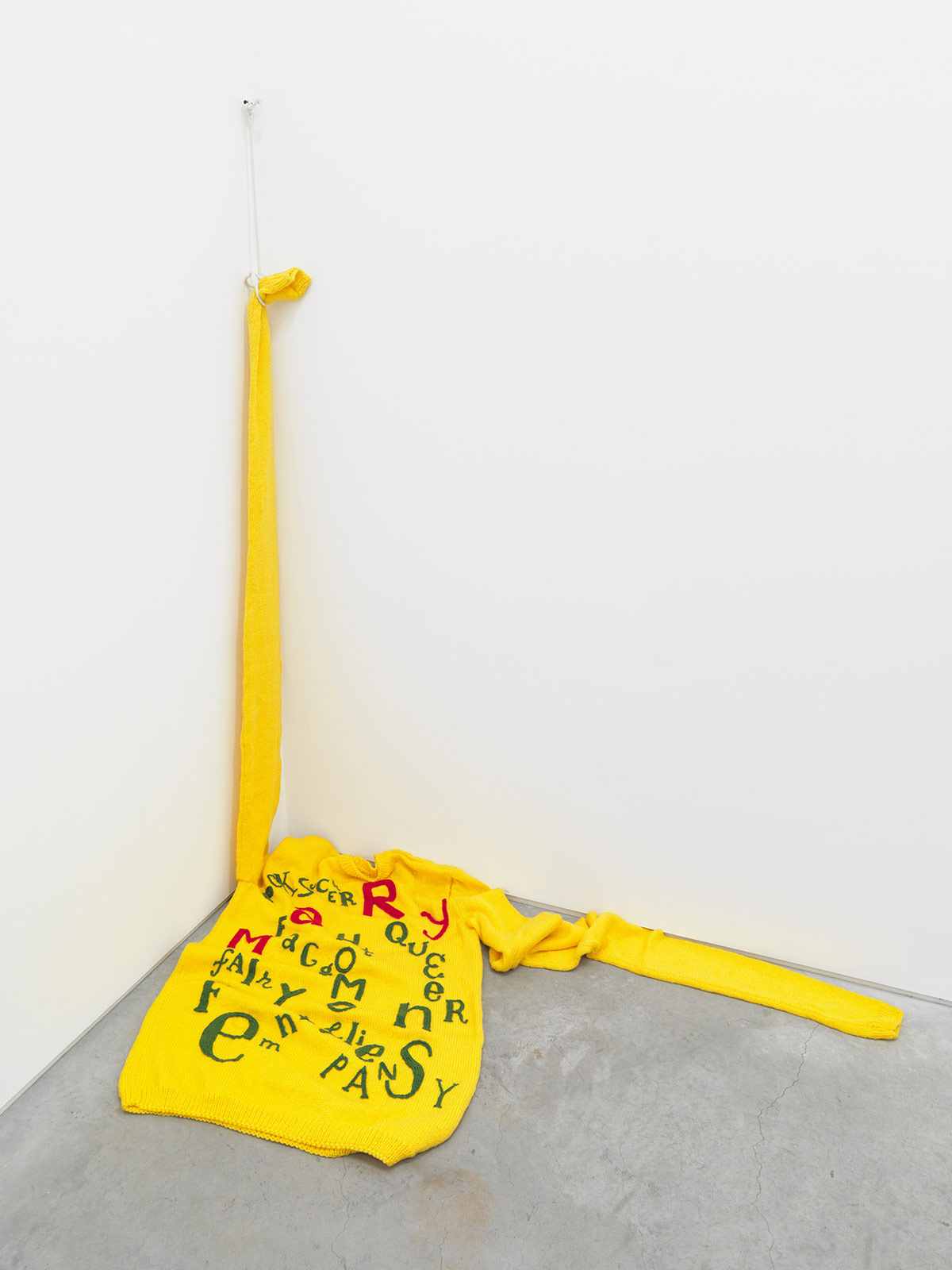
Kate: Wow. I am really keen on that piece. Whenever I see it. It’s transformative.
Peter: I made t-shirts with it. Yellow t-shirts and they sold out. I had to make more.
Kate: Oh god. We’ll talk later!
Peter: And a sweater. A huge sweater. Like a sweater for a giant, with long, long, long arms. I should walk around Christopher Street on the Gay Pride Day with it on ‘cause there’s no Gay Pride and I’ll just put it on and just walk around.
Kate: It’s outstanding. “A Friend of Dorothy.” It’s stupid of me. I should remember the name of it because I know the piece so well.
Peter: Yeah, you know the saying now.
Kate: Yeah, sure. Of course. So, this past May 31st was the 30th anniversary of my friend Carl Apfelschnitt’s dying from AIDS. And, I was just thinking this is sort of a compound question, who do you really miss from that time? Or, maybe I should rephrase it. It’s now 30 years since many of our friends died from AIDS and in November 1989, Cookie (Mueller) died. In May 1990, Carl died. And then, Robert Mapplethorpe. Robert (died in 1989 and Keith Haring was in the 1990s.
Peter: Thirty-one years old.
Kate: I was just looking at that and I was with him at William Burroughs’ in Kansas only a couple of years before then. I just wondering, who do you miss most of your friends who died from AIDS?
Peter: Well, of course, I miss the ones close to me, like Justin and Simon, Maurice and people I knew but, there was this article in Entertainment Weekly, when they had all these weird mutant action movies, and they asked all these movies stars, “what secret powers would you like to have?” And one would say, “I’d like to have x-ray eyes,” “I’d like to be able to blah, blah, blah,” “I’d like to fly.” And, they asked John Waters and he said, “I’d like to have the power to bring back all my friends who died of AIDS back,” and I was stunned.
Kate: Touché!
Peter: And I was like, “to-fucking-ché.” It was so brilliant. I can’t imagine a world without John Waters, I hope he lives healthily for a long time.
Kate: Yeah, no kidding.
Peter: That, for me, stunned me. And, I thought, yeah, “fuck all these people wanting to have super-powers to show how great they are.” Here’s he saying, “I wish I could have all my friends,” like Cookie Mueller, like all those people. I think that’s incredible. I’d like them all back. And, that’s why I don’t ever want to be in a bad mood and spend my days being miserable. I’m challenged. I’m challenged with someone very close to me who has cancer. But I’m not going to be miserable and I’m not going to be a victim. Because I know that Keith Haring would have done anything to be alive and be living 30 years later. He would have been my age.
Kate: I know.
Peter: And, I know those people would be so… John Sex, my friend Maurice, my friend Simon. All of them would live in a cardboard box to be alive.
Kate: True!
Peter: I would! If I died, I’d say, I’ll live in a cardboard box for a year, if I’m be alive.
Kate: Your resolve and your courage in your own recovery from AIDS is really inspiring in your book, so…
Peter: Well, when I got better from AIDS, when I finally rejected McDermott’s raw food diet domination, he was furious when I went on the medication and it saved me. Luckily, I lived. They thought I’d die in three months and I went right back to being miserable. Everything sucks. The world’s horrible. And, I was like, really? And I was miserable until, maybe five years ago or something? I just thought, I don’t ever want to waste my day being miserable for no reason, just to be miserable. One can be upset. If you’re miserable, you’re ill. It’s terrible to feel ill. It’s miserable if you lose somebody who died or your mate leaves you. That’s unhappiness. So why be miserable? You have the three basic needs: food, clothing, and shelter. I remind myself every day — I have food, clothing and shelter — the three basic needs that most of the world, does not have.
Kate: Correct. I agree.
Peter: So, I do not want to be miserable for no reason. Now, I have some feelings for my friend who’s ill. You know, I have emotions, but I still keep going. I don’t ever want to blame my boyfriend, my current boyfriend that I’ve been with for almost seven years… I don’t want to make his life miserable because I’m miserable. Like, you’re always late! or I didn’t want French Fries! or whatever stupid thing one could make into an argument. And, I never want to do it. I just think, this is the person that I love, and I don’t want to put my demented scenarios that go on in my head onto him. And that’s why I wrote that book so well because I live in demented scenarios.
Kate: Well you know I’m a big a fan of your book but the reason I’m a fan of it is because it reads itself. It’s just so well done. I wanted to ask you another question, which is I feel that with your relationship with David McDermott, as I was rereading your book last night that you were… this isn’t too deeply analytical or personal or anything, it’s just a question. I was just curious. I feel that with David McDermott that you were entranced by his intelligence and his commitment to his ideas, but that you were frustrated…at his actions. How did you arrive at the ultimate conclusion, which was “if only I could’ve controlled McDermott better,” in your book?
Peter: Well, he is a tough bean. He was nice to me at the beginning because he was courting me, and no one had ever shown me so much attention. I mean, he really wanted me. And I was like the horse he rode in on. He got on my back because I was a worker. I wanted to paint every day. That’s what I wanted to do. I didn’t want to do the interiors and the walls. And all that was great. He was more interested in the look; I was more interested being in the studio. He’s a highly intelligent person and extremely creative and original, but the mental condition is damaging, and he fights a lot. I didn’t want to trash him in the book. All I just wrote about was what happened, like kind of like what journalism is supposed to be and not an opinion. When I say, then he did this and then he did that. There were a lot of things I left out of the book. I didn’t want it to be a score-keeping book, and thats what the Bookforum Sam Mckinniss wrote. This surprisingly fresh form of score-keeping or whatever he wrote, like most books. And, I left people out of the book that ripped me off, that were very cruel to me, that were my “friends.” One, I was dying of AIDS and I hooked him up with this art dealer in Switzerland to sell some photographs of mine that my landlord had and I said, “okay, we’ll split what we do” and he cut me out of the deal and I’m dying of AIDS. I was desperate for money, so I didn’t put him in the book because, I thought it was better to be ignored. And you know what? Two of the people that I cut out of the book that posted on social media about how horrible I am, and I didn’t even want to put them in the book. I was so flabbergasted. Gob smacked when I saw that and Oscar Wilde’s quote is, I don’t remember the quote, but he’s basically saying “ignoring someone is the worst” because you’re not engaged.
Kate: Oh, I didn’t realize that. I kind of thought that myself. So, Oscar Wilde said that?
Peter: It’s the best revenge if you ignore them because you’re not engaging with them. And so, I didn’t want to engage with these people, and I didn’t realize… I didn’t want my book to go there because there was too much more to tell. Those two people posted “and I was left out of the book,” they just attacked me. But, they both stole from me! Literally stole from me.
Kate: Well, it’s their loss because, I hate to say this, but I would have loved to have been in that book, anybody would. It’s so brilliant but I really agree with you, that the only thing left is the work.
Peter: Yeah, that’s it. Everyone’s dead. All the personalities are gone. The dealers, the artists, the collectors, the critics, the private dealers, the fanfare, the writers, the printers… they’re all gone. I’m mean all that’s left of Robert Mapplethorpe are the photographs.
Kate: Also, like all of the parties are gone. All of the mood swings are gone.
Peter: All the affairs! The insults.
Kate: All of your resentment. Not to sound corny, but yeah. The only thing left is the work. When someone dies, you look up at the bookshelf or you look up on the wall. That’s it right?
Peter: Or, you listen to the music. That is how history is told. History is told by the art. Someone wrote it down, someone took a photograph of it, someone wrote a song about it. Hip-hop is about the history of racism in music, in poetry. Hip-hop artists are poets and you know, fuck the police, all of those songs, those rebellious songs, that’s how it’s remembered through the music, through the paintings all of that because everyone’s dead. What’s left of the ancient world? broken statues and crumbling buildings. That’s what’s left. So really is one’s opinion, their taste opinion, worthy? What’s left from the ancient world is the writings of Seneca, Plato, all different philosophies. Eastern philosophy which, still, for me, resonates so true, but I think that is why I want to enjoy this life. I’m not vain enough to say what happens when this body no longer is. I don’t know. I’ve never been. I’ve been close five times, I’ve been close, but I’m not vain enough to say there’s nothing and I’m not vain enough to say there’s something. I never went! And, I’m just saying this is what I know….so, if I’m a kind person… I try not to be rude on purpose because I’m rude by accident. So, I try and be a kind person, also thinking like how people drive me crazy, they terrorize me sometimes. Just the weirdness of the world. Especially what’s happening now! And, I think… stand up, show up, follow up, be kind, and hopefully your life works. You never know… look at that man Ahmaud Arbery, he went out for a jog in the morning and these white trash men killed him! He didn’t think he was gonna die on his run. You never know! The horror, or the time and day of your demise.
Kate: I know, I know. I want you to talk about the Oscar Wilde Temple.
Peter: Yeah, go ahead. Push me around. The Oscar Wilde Temple.
Kate: I just wanted to say before we get to The Oscar Wilde Temple, as I was re-reading your book again last night, it’s kind of almost felt quaint when you were talking about Quaaludes and Studio 54. I don’t know if quaint is the right word. There was a time when you could go to this palace where people were wearing silver shorts and taking Quaaludes.
Peter: It was when New York was raw. And we were bankrupt. I moved here in ’77. The fall of 1977 and it was a bankrupt dirty city and I loved every block. I now live in the West Village and it looks like a set from Friends, that TV show, no gays, no blacks, no people of color. Strictly white straight people. That’s what the West Village is now but when I moved there, there were giant LGBTQ people there; Marsha P. Johnson, Sylvia Rivera, Randy Wicker, these are the people who fought for gay rights, lesbian rights. Those are the people that should be glorified! Who cares about Lady Gaga? I mean, she’s great. She’s very LGBTQ friendly and stands for people. But, these nobodies, people of the street, those are the ones who fought. Randy Wicker who had a lamp shop on Hudson and Christopher, he marched and protested in 1964 in front of the White house in Washington.
Kate: I agree with you, and I remember when the West Village was like that and it is quite different, I agree.
Peter: It’s a bore. It’s a bore. Another French looking coffee shop. Give me a break.
Kate: I know! I just wanted to say I was always impressed by you and Peter and your sort of 19th-century time experiment, your time machine, and everyone was very impressed with that. I just wanted to say that when David McDermott who I know as well, left in 1994, how did things change for you? And, do you work with him and how does that work out? That was sort of my last question before we talk about the Oscar Wilde Temple.
Kate: So, when he left in 1994…
Peter: I followed him because what was important to me was the work, the vision of the work, but once again, when the money came in… basically, we became rich again when I moved back to New York and got healthy. I moved back here and I thought, “I’m not going back to Dublin.” There’s no art scene there. There are no collectors. We never sold. We sold maybe three pieces of art in Ireland. We sold in Europe and we had European dealers but when I moved back, I started doing these 1950s paintings about my understanding of hidden homosexuals and they sold like crazy. Crazy. We made so much money. I just shoveled it into his furnace to burn. And I did the same too. Lost it all.
I wish him well. Anyway, the Oscar Wilde Temple.
Kate: Yeah, what motivated you to do it? And, what’s the significance to you personally and what it reflects in regard to Oscar Wilde?
Peter: Years ago, McDermott said he wanted to start a religion. Like Mary Baker Eddy started a religion. He liked to dominate conversations and he wanted to do this religion. I had this book called The Oscar Wild Files and in it were pictures from the newspapers of the period of Oscar Wilde on trial, and illustrations, and I thought: What if these illustrations were the stations of the cross? And I painted a painting that’s in my storage in Dublin, I only painted one, and then I never did anymore. And this is the story how it came into fruition. I was living on Christopher Street and I was offered a show in a castle in Ireland that had a gallery. A very famous family of England, they had this chapel on the grounds and they offered me a show. I told my Aileen Corkery in London I could do a painting show, a photography show, a sculpture show, a film show. You know, those were the mediums I worked in. And, they said, “well, let’s do a photography show.” Because this one collector had a lot of my early photography. This collector bought a dead dealer’s archive and they have over 100 of my photographs from the 80’s and early 90’s. And, they said, we’ll do a photography show. And, I knew this curator that I did a show within the Dallas Museum of Contemporary Art. Alison M. Gingeras and she was going to curate the photographs and they were thrilled. Then, I looked out of my window on Christopher St and Governor Cuomo was marrying a same-sex couple in front of the Stonewall Inn and it was being landmarked as a nation Institution. Now, I looked out the window and then in Ireland they had voted for gay marriage and then, in the United States, about a week later…two weeks, a month, I don’t know, they had passed it in Congress in the U.S. And, when I saw this wedding out of my window, I thought, I can’t do a photography show. I have to make the Oscar Wild Temple. Not a church, not a chapel, it’s a temple. And, I called up Alison and I said, “listen, I have this great idea. Why don’t we do, instead, because of the Marriage Act, the Oscar Wild Temple and people can get married in it?! And she was like, “I’m thrilled.”
Kate: That’s great.
Peter: She’s like, “this is amazing.”
Kate: They were the 12 stations of Reading Gaol?
Peter: Yeah, the stations of Reading Gaol and I had a statue of Oscar Wilde carved out of linden wood. There was a side altar to AIDS… the people who died of AIDS, that you could write their name in a book and then a side altar to the people who were killed because of whom they were. LGBTQ and they were either Latin, Black, Asians, anybody. Whomever was murdered. Then I went to my computer and typed in “Trans Murders,” wow, you should have seen this list. I was so horrified.
Then, with the chapel in Ireland, they said we have to cancel the exhibition because the locals are protesting, and they think I’m making fun of the Catholic church. And I surprised myself and Lord Burlington because I said, “you know what? It’s okay. I understand, it’s such a great project… why don’t… maybe we’ll do it down the road?” And then, I called Alison and I spoke, and she said, “this is terrible. I don’t want this project to end,” so she pushed it with Dorothy Berwin to do it at LGBTQ Center in New York, but since they didn’t have enough rooms, we went to the church, which had the first parents and friends of gays and lesbians PFLAG, we did it in a small chapel down there and then Joe Scotland through my friend Aileen Corkery and Alison Gingeras became interested, he visited and offered me a show. When it went to London to Studio Voltaire that was an old Methodist chapel. It was huge and they did everything I suggested. They went above and beyond. In New York, it was wonderful; in London it reached the sublime! Studio Voltaire they said they never had so many visitors there!
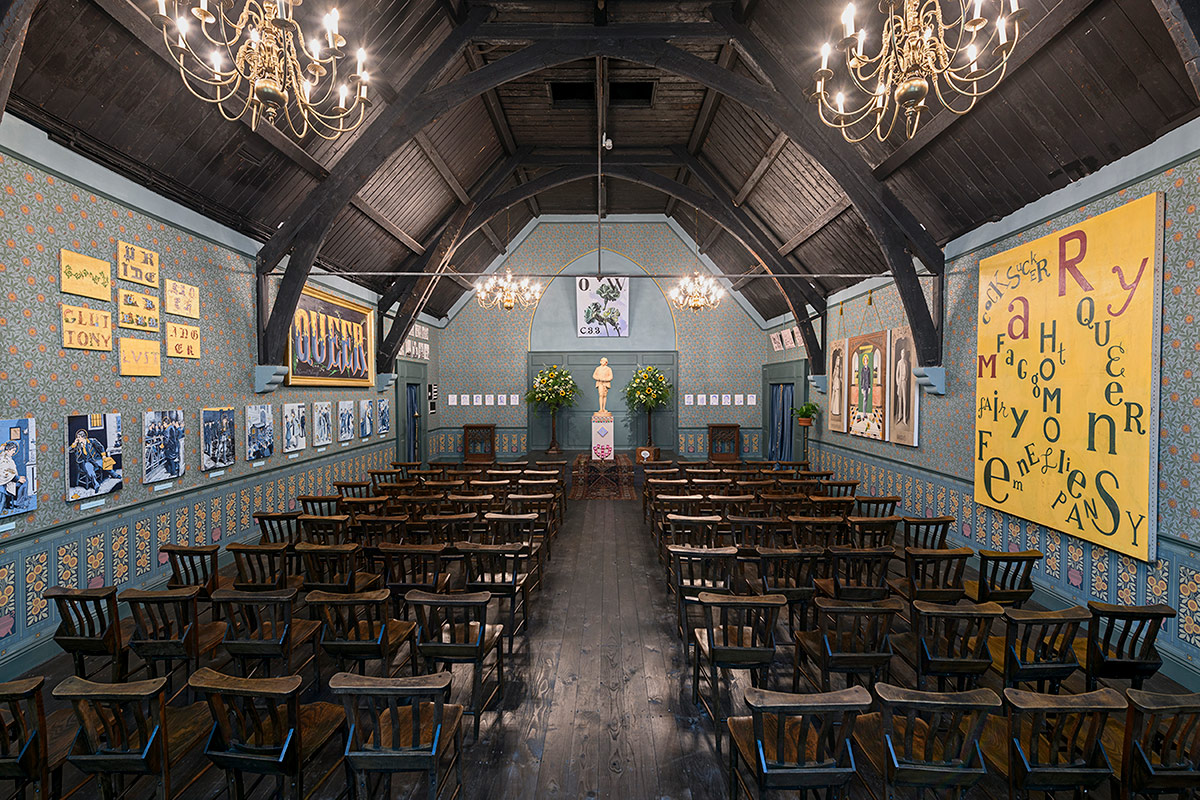
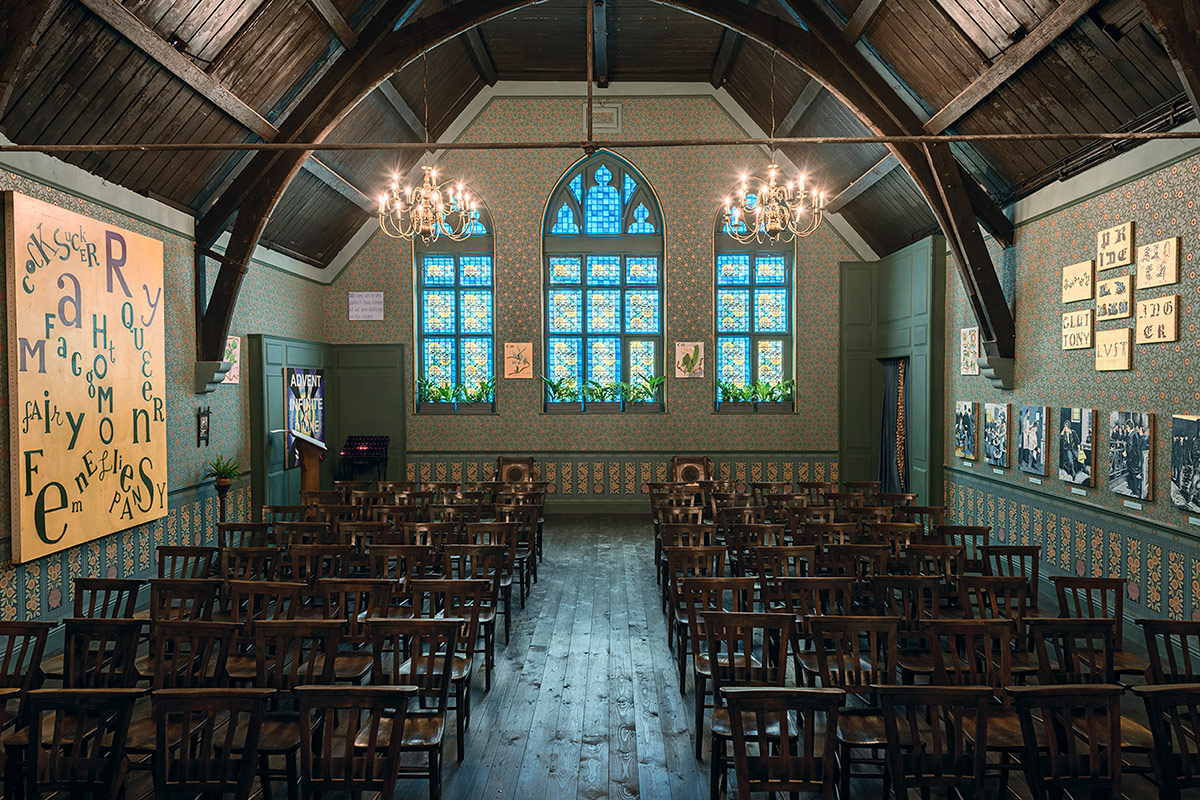
Kate: I heard that.
Peter: And what I did was, I said, alright let’s do it. I insisted we had to raise money for LGBTQ homeless youth, the most vulnerable of the community. At the opening dinner with the (who’s who) of the London art world, I took the microphone and we had little donation cards on the tables, and I said, “Alright, it’s time to get your wallets out.” And they were like, “Well, we don’t do this in London,” and I said, “Well, there is always a first time.” And, I raised $40,000 and that allowed two kids to get off the street to have their own apartments for a year. And, it’s going to go in London again. It’s being purchased by an institution and I said, there has to be a collection box that the Albert Kennedy Trust in London has the key to and every coin in that box has to go LGBTQ youth.
Kate: I think it’s important to mention this, that Oscar Wilde himself died at 42 and when he was in prison, he was not allowed to speak! And here was this unbelievably lucid, eloquent genius and he couldn’t speak and when he got out of Redding jail, he was broken. I mean, it did break him.
Peter: It broke him. That book that came out in ‘80s is heartbreaking.
Kate: Which one in the ‘80s?
Peter: Oscar Wilde by Richard Ellmann. It’s a big heavy book. I read it in the ‘80s and I read it again before New York and I read it from when he was arrested. I went right to the arrest in the book and that man, I mean he slept on a board. He went to three prisons, the third one was Redding Goal. How he was harshly treated by his friends, only a few stood by him, Aubrey Beardsley denounced him and it’s so heartbreaking, and I thought, now he’s regarded as the genius that he always was. So, I made a statue to him and I said to a young curator that came to visit me from MOMA, I said, “I don’t want it to be just about white people.” And she said, “I’m so happy you said that,” because yes, it’s Oscar Wilde, but behind him are all the people like Harvey Milk or this young black lesbian who was shot when she said “I’m gay” and they killed her, or Teena Brandon, A man who was jogging in the park in London and was killed because he was gay and I showed pictures of what they did to gay people in the Renaissance. They had public hangings of them, and the painting showed what they did to them in China. What happened when the conquistadors arrived – they sicked their dogs on them. They destroyed… they killed them with dogs ripping the bodies apart. And the people that conquistadors killed were considered shamans in their own world. I wanted to show that every religion has denounced gays, lesbians, bisexuals and transgenders. Save for the Episcopal church, which is one of the few, with a gay bishop.
I was raised in the Catholic church and my parents were extremely religious and everybody was equal in god’s eyes, everyone, Blacks, Latins, Asians. There was one group that wasn’t, and I was part of that group and I knew, I better keep quiet. All while they were molesting the kids in the school. Boys. You know, they’re denouncing homosexuals as the principal of my High School molested boys.
Kate: I want to footnote what you were just discussing. Let’s remember that homosexuality was illegal in the USA until 1966, which isn’t that long ago.
Peter: No. And it was legal in Paris but Oscar Wilde’s mother said, “You’re no son of mine if you run away,” so he stayed and I won’t go into the trial but, he was mocked during his time and there is a recent book about Wilde going to America for a lecture tour. He was famous for being famous. This was before he even wrote Dorian Gray and they mocked him in the press, they drew pictures of him, people thought he was a fool. He was a Big Mouth and, I just say, well, that was his life, so… look how it’s reversed now. So, whomever is listening to this or reading this; however, it comes out: Live your life! Live your life the way you want it. If you want to walk around with a chicken on your head and you’re not hurting the chicken, go ahead! If you wear a balloon hat, go ahead! Because the world is mediocre at best. If we’re watching a TV show about some family that’s super-rich and their boring intrigue, gimme a break! Or housewives — I mean, that’s your life! Watching these people complain and fight and get drunk? Are you kidding me? Why don’t you just bury yourself with a TV set, too, so you can go to wherever you go with the TV? The world is absurd and if you want to take a risk in your life, like I pushed that Oscar Wilde Temple — I had to raise the money. There wasn’t a gallerist of mine who wrote any checks and said, “Here’s the check.” I mean a gallery that represented me at the time, they didn’t even come to it. I had to do it myself. That’s another whole conversation about who’s supporting whom. But, I think it’s the most important artwork I’ve ever created because it’s not about me — it’s about people. And I had a sign at a front of it that was hand-painted by a sign-painter that said, “No Homophobia, No Racism, No Misogyny etc. Only love is allowed here.” at the entrance of it, that’s what this temple is for, it is a safe haven for my community and it’s admirers. And, that was important because what’s great about a gay bar for people is it’s where they can be themselves as funny or outrageous or sexy — or whatever they want to be. They don’t have to have the prying eyes of a straight world saying, “You’re not supposed to be that way.” You know what? Back off. I’m not interested in telling you how to live your little L.L. Bean life in suburbia. Don’t tell me that I’m depraved while you sit in front of a TV set your whole day. I mean that’s the modern world. You wake up and look at a screen, then you go to work and look at a screen, you go to the gym and run in front of a screen and then you go back home to sit in front of a screen and then, the next day, it’s the same thing. And that, is called insanity.
Kate: Well, that is where we’re at right now. Insanity. I’ll tell you something, Peter, I think that you’re great and I think this is a good place to stop because I wanted to make sure to cover your book and to cover your temple and I’m such a huge fan of your work. I just think that it’s wonderful to talk to you and I think this is perfect for Gay Pride.
Peter: Likewise. I think you’re great and the perfect person to talk to and it’s a great place to end it at three o’clock.
Kate: Okay, well, God bless you and we’ll talk soon, alright?
Peter: I’d love it. Alright, sweetheart. Lots of love. Take care of yourself. Bye hun.
Kate: Bye.
